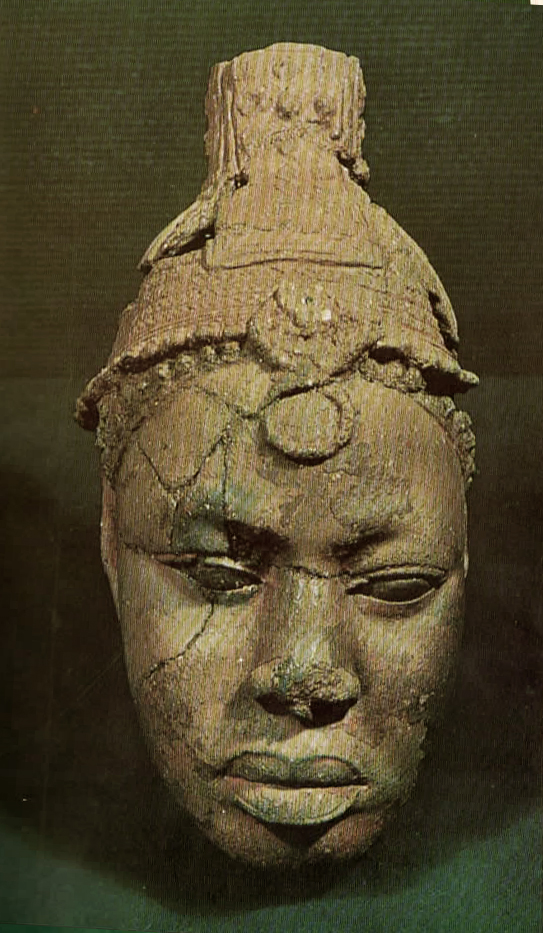wolfgang-jaenicke
A bronze head of Lajuwa
A bronze head of Lajuwa
Couldn't load pickup availability
A bronze head of Lajuwa, Nigeria, a sculpture which is remembered in both Ife and Benin oral traditions as a figure of historical and symbolic significance, particularly in the narratives concerning the transmission of kingship, sacred authority, and artistic traditions between these two centers of Yoruba and Edo civilization. The accounts vary depending on whether they are told from the Ife or the Benin perspective, but they converge on his role as a priest, diviner, or intermediary associated with the sacred head (orí) and the sea deity Olókun.
In the Ife corpus, Lajuwa is described as the chief priest of Olókun, a deity of wealth, fertility, and the oceanic realm, whose cult played a central role in the spiritual economy of the ancient city. As Olókun’s attendant, Lajuwa maintained the connection between ritual practice, political legitimacy, and the cosmological order that underpinned the authority of the Ooni. His duties linked the royal household to the metaphysical sources of prosperity and order. In some versions, he was also custodian of the sacred paraphernalia connected with Ife’s royal ancestors and early bronzework.

A Lajuwa terracotta sculpture in the National Museum of Lagos.
In Benin tradition, the figure of Lajuwa (sometimes called Igueghae or a similar cognate) appears in the narrative of the founding of the Benin monarchy. When the Edo elders sought a legitimate ruler from Ife, the Ooni is said to have sent Oranmiyan, accompanied by ritual specialists and smiths, among whom Lajuwa was prominent. He thus became a mediator of ritual knowledge and bronze-casting techniques, serving as a link between Ife’s spiritual authority and Benin’s emerging royal ideology. His association with the cult of Olókun may have facilitated the transplantation of that deity’s worship to Benin, where it took on local forms within the palace religion.
Archaeological and art-historical scholarship, particularly that of Suzanne Preston Blier and Ekpo Eyo, has noted that the memory of figures such as Lajuwa embodies the transference of artistic and religious systems from Ife to Benin during the early second millennium CE. The continuity of iconographic and technical elements in bronze casting—the naturalism of facial modeling, the symbolic role of the head, and the ritual use of metal—may be interpreted as reflecting the historical roles of these mytho-historical intermediaries.
In Ife itself, Lajuwa’s shrine reportedly persisted into the twentieth century as a locus of Olókun worship, suggesting that his cultic presence was not merely historical but remained ritually significant. His name thus encapsulates both a personal and a symbolic continuity between two of West Africa’s most important centers of sacred kingship and artistic innovation.
Frank Willett, Ife, plate VII.
References
Blier, Suzanne Preston. Art and Risk in Ancient Yoruba: Ife History, Power, and Identity, c. 1300. Cambridge: Cambridge University Press, 2015.
Eyo, Ekpo, and Frank Willett. Treasures of Ancient Nigeria: Nations of Africa. London: Thames and Hudson, 1980. Ben-Amos, Paula Girshick. The Art of Benin. London: Thames and Hudson, 1995.
In Nigeria's National Museum in Lagos we find a terra-cotta head which is called “Lajuwa” Head, found in the Ife Palace, Ile-Ife, 12th - 15th century. „ The head ... was said to have been kept in the king’s palace. It is called Lajuwa, who is remembered as the usurper who became king when Oni Aworokolokin died (Eyo and Willett 1980, p.103).Dark, Phillip. An Illustrated Catalogue of Benin Art. G.K. Hall & co: Boston, 1982. Illus. 31.
Height: 43 cm
Weight: 5 kg






































